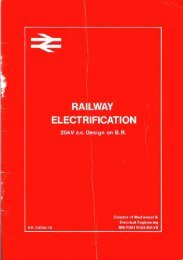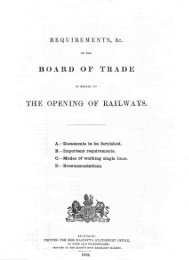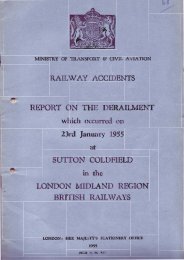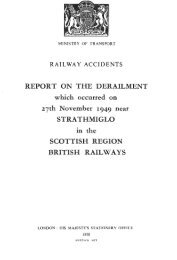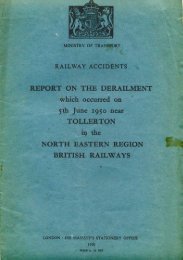R A I LT R AC K - The Railways Archive
R A I LT R AC K - The Railways Archive
R A I LT R AC K - The Railways Archive
You also want an ePaper? Increase the reach of your titles
YUMPU automatically turns print PDFs into web optimized ePapers that Google loves.
Route characteristics<br />
DESCRIPTION <strong>The</strong> West Anglia Main Line runs from London to King’s Lynn via<br />
Cambridge with several suburban branches and a link to Stansted Airport. <strong>The</strong><br />
combination of the main line through the Lea Valley and the Southbury Loop<br />
(Hackney Downs to Cheshunt) creates a four-track railway between Bethnal<br />
Green and Cheshunt. Otherwise the route is two track, with a small number of<br />
single-line sections. <strong>The</strong> maximum speed on the main line is 90mph.<br />
<strong>The</strong> route from Norwich to Ely and Peterborough connects East Anglia to<br />
the Midlands, the North and Scotland.<br />
Apart from the Norwich–Peterborough section, all lines on the route are<br />
electrified.<br />
BOTTLENECK ANALYSIS Studies of capacity have shown that if the current<br />
service pattern is maintained, there is sufficient space available on existing trains,<br />
Route vision<br />
<strong>The</strong> West Anglia Main Line serves densely populated areas at its southern end<br />
and some key locations at its centre, including Cambridge and Stansted Airport.<br />
Our vision for this route is to provide frequent and reliable high-quality services<br />
to all destinations, with comfortable capacity for many years to come. <strong>The</strong> rapid<br />
growth of the region means that significant investment is needed in the<br />
infrastructure to meet these needs, and we have started a major renewal of the<br />
signalling, telecoms and overhead-line between London and Elsenham. In<br />
addition, we have assessed opportunities for further enhancements:<br />
Maximise current capacity (£10M) Extend platforms to allow longer trains,<br />
but some journey times would have to be increased, or station stops reduced, to<br />
accommodate a service of four trains per hour to Stansted Airport.<br />
Stimulate rail growth (£60M) As well as the platform works above, include<br />
an additional track between Cheshunt and Broxbourne to accommodate four<br />
trains per hour to Stansted Airport without disrupting existing services. <strong>The</strong>re<br />
would be limited operational flexibility to recover from incidents or to handle<br />
exceptional demand.<br />
and later by extending trains, to cater for predicted peak demand for at least the<br />
next ten years. However, the Franchising Director, WAGN and Central Trains<br />
aspire to operate more frequent services (peak and off-peak) to Stansted Airport<br />
in order to further stimulate growth.<br />
This new custom, in addition to underlying growth, means that demand for<br />
paths is expected to continue growing strongly beyond the expiry of the WAGN<br />
franchise (2004) and the current plan horizon (2009). To satisfy this continuing<br />
growth, we may need to alter the track layout and signalling (see below).<br />
<strong>The</strong> key driver for the route is capacity, which is restricted by the mixture<br />
of fast and stopping services.<br />
A prerequisite for capacity enhancement is to modernise the basic signalling,<br />
telecoms and overhead-line equipment. This year, we will start work on a major<br />
modernisation scheme, and will complete the first stage in 2001.<br />
High specification (£113M) In addition to the previous options, install an<br />
additional track between Brimsdown and Northumberland Park and upgrade the<br />
signalling capability. This would provide full operational flexibility for all forecast<br />
services to all destinations with standard setting reliability.<br />
To take this forward, we are working with the Franchising Director, industry<br />
partners, local authorities and others to determine the best specification for the<br />
infrastructure to 2008 and well beyond.<br />
None of the options above include improving capacity of the Stansted<br />
Airport terminal, which we are evaluating separately.<br />
We will continue to improve our stations and, in particular, address<br />
integration with other transport modes, improved passenger information and<br />
access for the disabled.<br />
217



